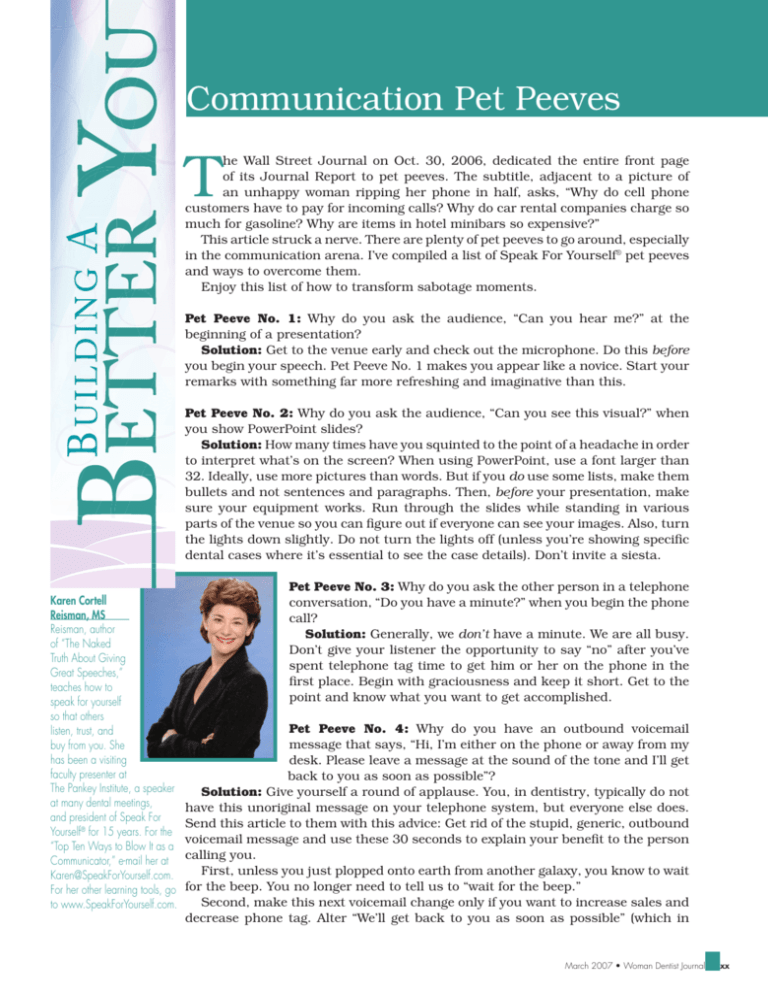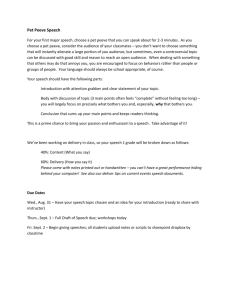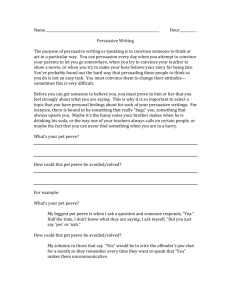Communication Pet Peeves
advertisement

Communication Pet Peeves T he Wall Street Journal on Oct. 30, 2006, dedicated the entire front page of its Journal Report to pet peeves. The subtitle, adjacent to a picture of an unhappy woman ripping her phone in half, asks, “Why do cell phone customers have to pay for incoming calls? Why do car rental companies charge so much for gasoline? Why are items in hotel minibars so expensive?” This article struck a nerve. There are plenty of pet peeves to go around, especially in the communication arena. I’ve compiled a list of Speak For Yourself® pet peeves and ways to overcome them. Enjoy this list of how to transform sabotage moments. Pet Peeve No. 1: Why do you ask the audience, “Can you hear me?” at the beginning of a presentation? Solution: Get to the venue early and check out the microphone. Do this before you begin your speech. Pet Peeve No. 1 makes you appear like a novice. Start your remarks with something far more refreshing and imaginative than this. Pet Peeve No. 2: Why do you ask the audience, “Can you see this visual?” when you show PowerPoint slides? Solution: How many times have you squinted to the point of a headache in order to interpret what’s on the screen? When using PowerPoint, use a font larger than 32. Ideally, use more pictures than words. But if you do use some lists, make them bullets and not sentences and paragraphs. Then, before your presentation, make sure your equipment works. Run through the slides while standing in various parts of the venue so you can figure out if everyone can see your images. Also, turn the lights down slightly. Do not turn the lights off (unless you’re showing specific dental cases where it’s essential to see the case details). Don’t invite a siesta. Karen Cortell Reisman, MS Reisman, author of “The Naked Truth About Giving Great Speeches,” teaches how to speak for yourself so that others listen, trust, and buy from you. She has been a visiting faculty presenter at The Pankey Institute, a speaker at many dental meetings, and president of Speak For Yourself® for 15 years. For the “Top Ten Ways to Blow It as a Communicator,” e-mail her at Karen@SpeakForYourself.com. For her other learning tools, go to www.SpeakForYourself.com. Pet Peeve No. 3: Why do you ask the other person in a telephone conversation, “Do you have a minute?” when you begin the phone call? Solution: Generally, we don’t have a minute. We are all busy. Don’t give your listener the opportunity to say “no” after you’ve spent telephone tag time to get him or her on the phone in the first place. Begin with graciousness and keep it short. Get to the point and know what you want to get accomplished. Pet Peeve No. 4: Why do you have an outbound voicemail message that says, “Hi, I’m either on the phone or away from my desk. Please leave a message at the sound of the tone and I’ll get back to you as soon as possible”? Solution: Give yourself a round of applause. You, in dentistry, typically do not have this unoriginal message on your telephone system, but everyone else does. Send this article to them with this advice: Get rid of the stupid, generic, outbound voicemail message and use these 30 seconds to explain your benefit to the person calling you. First, unless you just plopped onto earth from another galaxy, you know to wait for the beep. You no longer need to tell us to “wait for the beep.” Second, make this next voicemail change only if you want to increase sales and decrease phone tag. Alter “We’ll get back to you as soon as possible” (which in March 2007 • Woman Dentist Journal xx Building a Better You many cases does not happen anyway) to “Let me know a good time to return this call.” Third, in your voicemail’s outbound blurb, ask the listener for his or her e-mail address and give your Web site address. Fourth, keep it short. Pet Peeve No. 5: Why do you say “honestly” or “to be candid with you” in a conversation? Is everything else you say untruthful? Solution: Watch out for verbal clutter. It’s hard to get rid of all the “you knows,” “ums,” and “uhs.” You need to wear an imaginary hat with these words embroidered on the rim: Get rid of clutter. This is an active rather than passive activity. Become more aware by listening to yourself when you speak. At the least, stop saying “honestly.” It diminishes everything else you’ve said and will say. Pet Peeve No. 6: Why do you tell someone that they look tired? Solution: Ann Landers once advised in her column to keep your mouth shut if you think the other guy looks haggard. If you express your concern, the situation does not change. The tired one doesn’t get less tired, just more upset that his exhaustion is apparent to everyone else. Pet Peeve No. 7: Why do you leave your phone number at warp speed on voicemail? Solution: How often have you been forced to re-listen to a mumbled number or a message that has been nicely articulated, but the number is stated in fast-speak? I beg you to make this tip a reality — today. If your patient or prospect must listen to your message four times to make sure he or she has the correct amount of digits for your phone number, he or she already doesn’t like you! Make it easy for the listener to want to continue connecting with you. Say, “My area code is 999. My phone number is 111-1111.” Say this slowly once at the beginning and again at the end of your message using your normal voice rate. Some of these pet peeves apply to you; some don’t. But keep this list handy so you can continue to speak for yourself with power and presence. ■ © 2006 Karen Cortell Reisman, MS xx Woman Dentist Journal • March 2007




